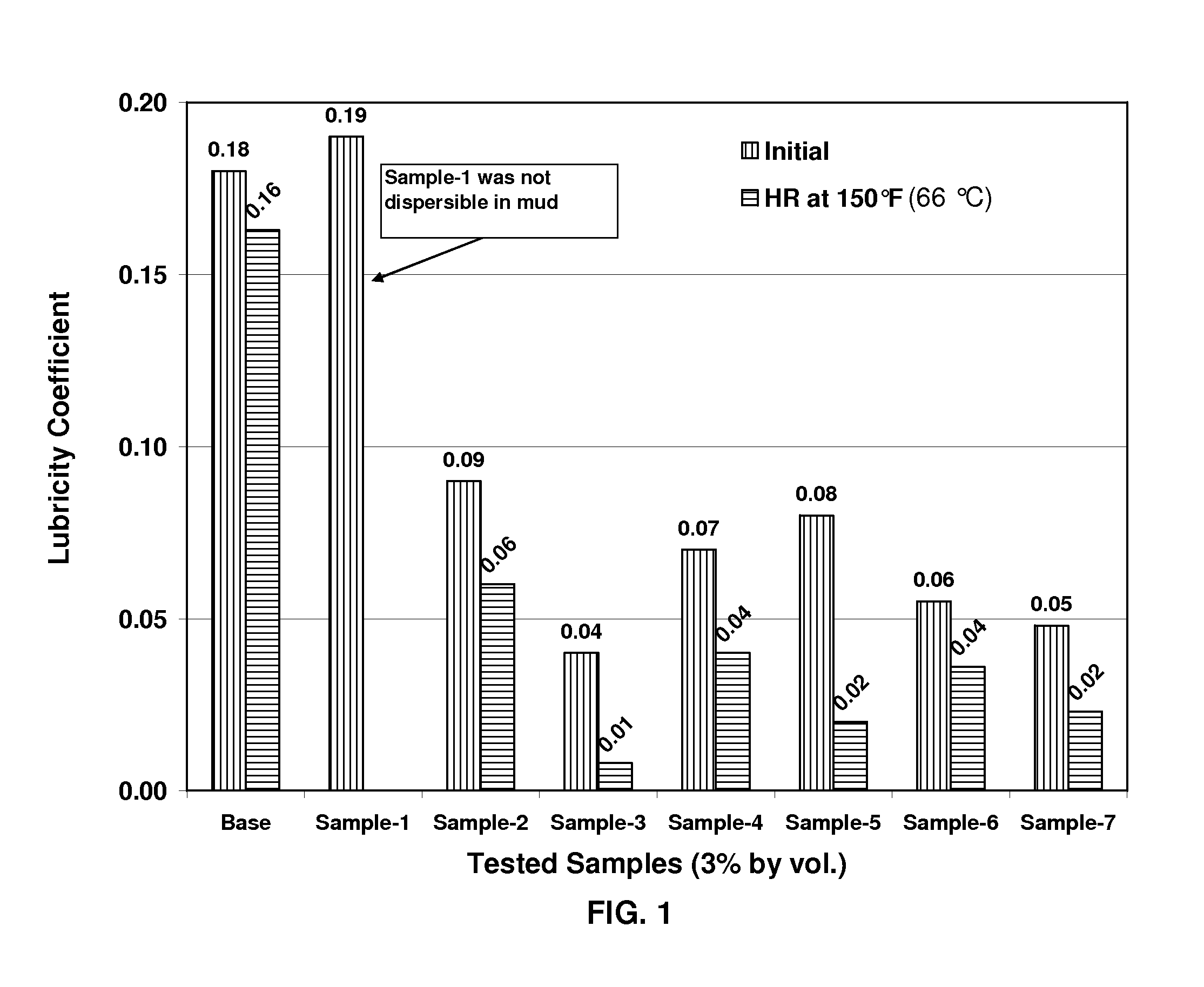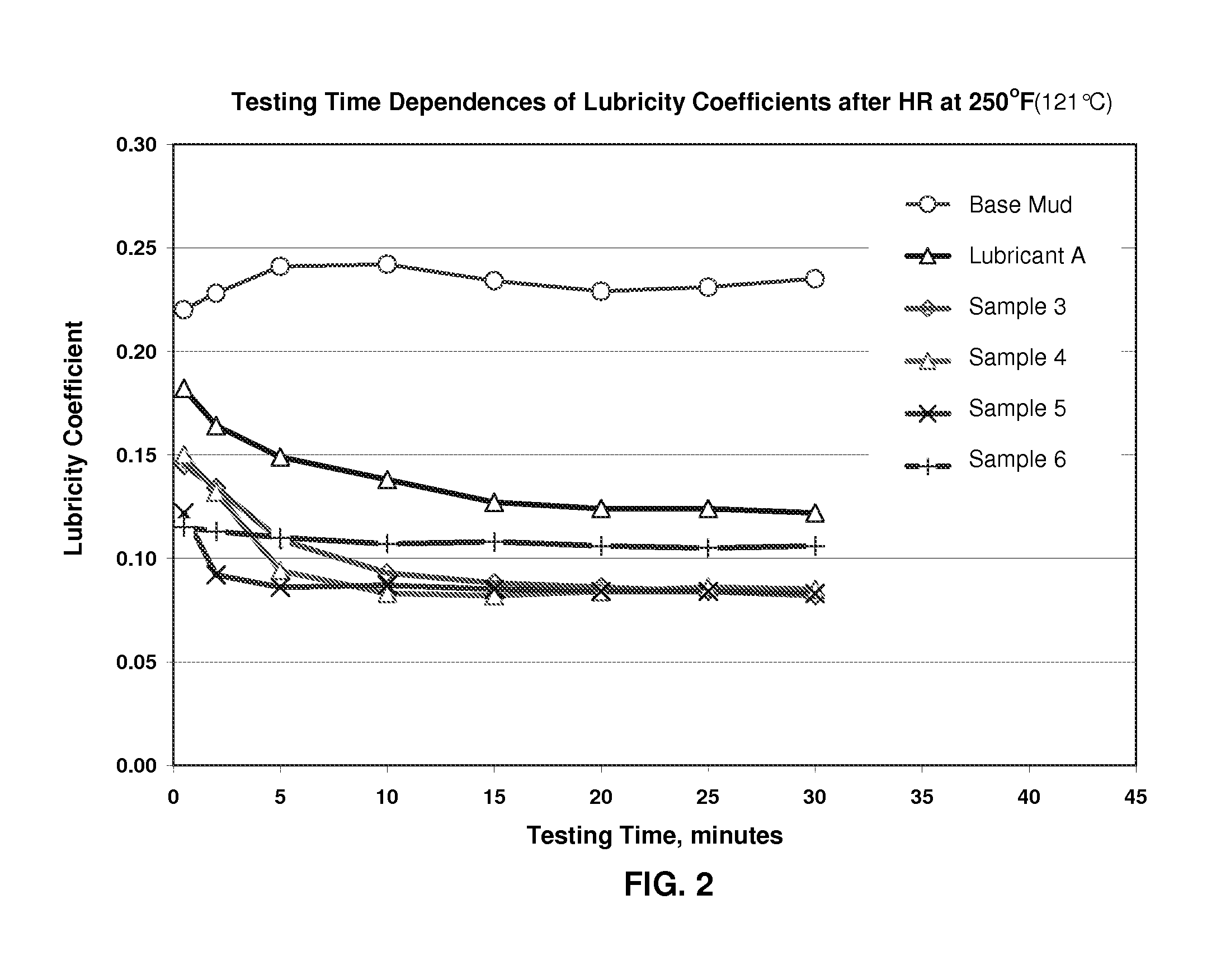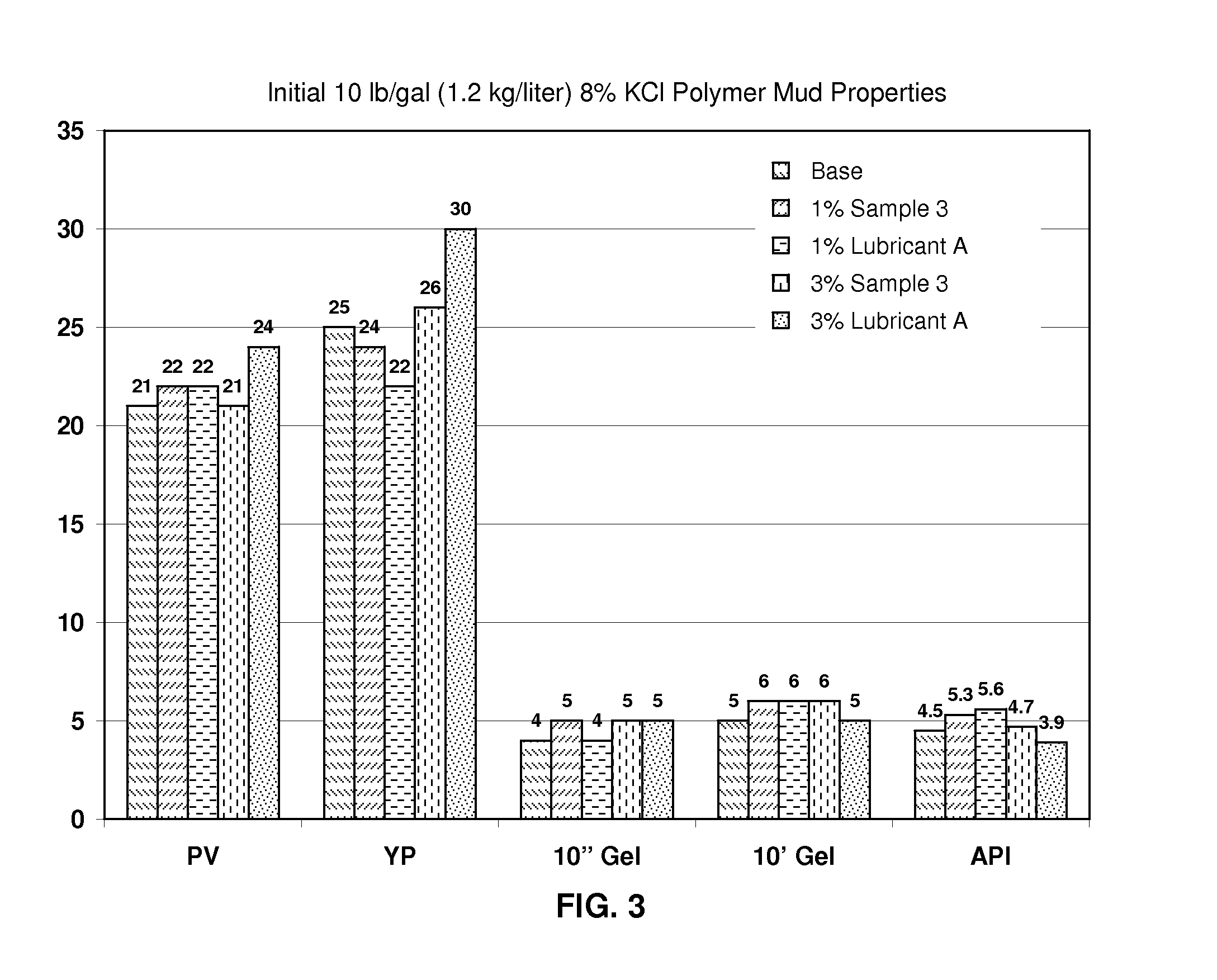Water-Based Mud Lubricant Using Fatty Acid Polyamine Salts and Fatty Acid Esters
a technology of fatty acid polyamine salts and lubricants, which is applied in the direction of lubricant composition, sealing/packing, and well accessories, etc., can solve the problems of pipe twisting or breakage, and the drilling rate is reduced
- Summary
- Abstract
- Description
- Claims
- Application Information
AI Technical Summary
Benefits of technology
Problems solved by technology
Method used
Image
Examples
example 1
[0027]A synergistic effect between fatty acid salts of diethylenetriamine (DETA) and fatty acid esters on improving water-based mud lubricity has been observed. The fatty acid esters used in these Examples are fatty acid esters of 1,3-dioxane-5,5-dimethanol. As shown in FIG. 1, the samples made by blending fatty acid salts of DETA and fatty acid esters (Sample 3, Sample 4, Sample 5, Sample 6 and Sample 7 in Table II) demonstrate much better lubricity in water-based drilling fluids than those fluids where only fatty acid salts of DETA (Sample 1 in Table II) or only fatty acid esters (Sample 2 in Table II) are used.
TABLE IBASE MUD FORMULATION FOR THE TESTS SHOWN IN FIG. 1Water, bbl (liter) 0.82 (130)MILGEL ®, lb (kg) 6 (2.7)XAN-PLEX ® D, lb (kg) 0.3 (1.4)NaHCO3, lb (kg) 0.5 (0.23)NEW DRILL ® PLUS, lb (kg) 0.5 (0.23)BIO-LOSE ®, lb (kg) 2 (0.91)MIL-PAC ™ LV, lb (kg) 1 (0.45)KCl, lb (kg) 25 (11)MIL-BAR ®, lb (kg)153 (69)Rev Dust, lb (kg) 27 (12)
TABLE IILABORATORY SAMPLE COMPOSITIONSTeste...
example 2
[0028]After aging at 250° F. (121° C.) for 16 hours, these laboratory samples performed better than a standard lubricant used in drilling fluid industry. FIG. 2 shows the comparison of the time dependence of lubricity coefficient for laboratory samples with a commercial available lubricity product termed “Lubricant A” herein (a mixture of fatty acids, esters with polyol and fatty acids C16-18 and C18-unsaturated compounds with 2,2,2″-nitriloethanol) after aging at 250° F. (121° C.) for 16 hours (sample compositions are shown by Table II). It may be seen that the lubricity coefficient is lowest for Samples 3, 4, 5 and 6 of the present composition in contrast to the base mud only and the commercial lubricant.
TABLE IIIMUD FORMULATION USED FOR THE TESTS SHOWN BY FIG. 2Water, bbl (liter) 0.82 (130)MILGEL, lb (kg) 6 (2.7)NaOH, lb (kg) 0.4NEW-DRILL PLUS, lb (kg) 0.5 (0.23)MIL-PAC LV, lb (kg) 1 (0.45)BIO-LOSE, lb (kg) 4 (1.8)ALL-TEMP ™, lb (kg) 1 (0.45)KCl, lb (kg) 25 (11)Malay Barite, lb (...
example 3
[0029]Further comparison of a 50 / 50 vol / vol blend of fatty acid salt of DETA and fatty acid ester-1 with commercially available Lubricant A in 10 lb / gal (1.2 kg / liter) 8% KCl mud system is made in Tables IV and V, and FIGS. 3, 4, and 5. Again, it may be seen that Sample 3 outperforms the commercial lubricant. This is particularly true with respect to the torque reduction results shown in FIG. 5.
TABLE IVCompositions of Fluids Used in Table V and FIGS. 3, 4 and 5Water, bbl (liter) 0.89 0.89 0.89 0.89 0.89 (141)(141)(141)(141)(141)Soda Ash, lb (kg) 0.5 1 1 1 1 (0.22)(0.45)(0.45)(0.45)(0.45)FLOWZAN ®, lb (kg) 0.5 0.5 0.5 0.5 0.5 (0.22)(0.22)(0.22)(0.22)(0.22)NEW-DRILL ® HP, lb (kg) 3 3 3 3 3 (1.4)(1.4)(1.4)(1.4)(1.4)MIL-PAC ™ LV, lb (kg) 2 2 2 2 2 (0.9)(0.9)(0.9)(0.9)(0.9)BIO-LOSE ®, lb (kg) 3 3 3 3 3 (1.4)(1.4)(1.4)(1.4)(1.4)MIL-CARB ®, lb (kg)10 10 10 10 10 (4.5)(4.5)(4.5)(4.5)(4.5)KCl, lb (kg)24.1 24.1 24.1 24.1 ...
PUM
| Property | Measurement | Unit |
|---|---|---|
| volume % | aaaaa | aaaaa |
| volume % | aaaaa | aaaaa |
| volume ratio | aaaaa | aaaaa |
Abstract
Description
Claims
Application Information
 Login to View More
Login to View More - R&D
- Intellectual Property
- Life Sciences
- Materials
- Tech Scout
- Unparalleled Data Quality
- Higher Quality Content
- 60% Fewer Hallucinations
Browse by: Latest US Patents, China's latest patents, Technical Efficacy Thesaurus, Application Domain, Technology Topic, Popular Technical Reports.
© 2025 PatSnap. All rights reserved.Legal|Privacy policy|Modern Slavery Act Transparency Statement|Sitemap|About US| Contact US: help@patsnap.com



